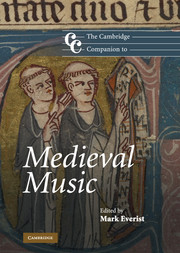Book contents
- Frontmatter
- Introduction
- Part I Repertory, styles and techniques
- Part II Topography
- Part III Themes, topics and trajectories
- 11 Music and liturgy
- 12 Vernacular poetry and music
- 13 Latin poetry and music
- 14 Compositional trajectories
- 15 Ecclesiastical foundations and secular institutions
- 16 Theory and notation
- 17 Music manuscripts
- 18 The geography of medieval music
- 19 Reception
- Notes
- Bibliography
- Index
12 - Vernacular poetry and music
from Part III - Themes, topics and trajectories
Published online by Cambridge University Press: 28 September 2011
- Frontmatter
- Introduction
- Part I Repertory, styles and techniques
- Part II Topography
- Part III Themes, topics and trajectories
- 11 Music and liturgy
- 12 Vernacular poetry and music
- 13 Latin poetry and music
- 14 Compositional trajectories
- 15 Ecclesiastical foundations and secular institutions
- 16 Theory and notation
- 17 Music manuscripts
- 18 The geography of medieval music
- 19 Reception
- Notes
- Bibliography
- Index
Summary
Prima lamusica, poi le parole: this assertion, the title of an opera by Antonio Salieri, wittily alludes to the conundrum faced by any poetic and musical collaboration. In the story of the opera the music is already written and the harassed poet is told he must write the verse to fit the music in just four days. It is not important, according to the musician, for the music to convey the meaning of the words. But of course this is a joke that works by inverting the usual expectations of any text–music relationship, especially in opera. One of the primary aims of this chapter will be to assess the character of this relationship in its earliest formation in the medieval period. Poetry and music come together in vernacular song to create some of the most subtly exquisite survivals of medieval music. The art of the troubadours in the twelfth century, closely followed by that of the trouvères in the thirteenth, persists in our time as one of the most vividly enduring images, not only of the medieval singer, but also of song tout court, and of the Middle Ages in general.
Yet many questions remain about the character of this art. It seems not only paramount but impossible to decide which comes first, the poetry or the music. In communicating so strongly across the centuries, medieval song teases us with the question of what it is communicating and whether what we hear or perform as we re-create it bears any relation to what was heard or performed in the Middle Ages.
- Type
- Chapter
- Information
- The Cambridge Companion to Medieval Music , pp. 205 - 224Publisher: Cambridge University PressPrint publication year: 2011



